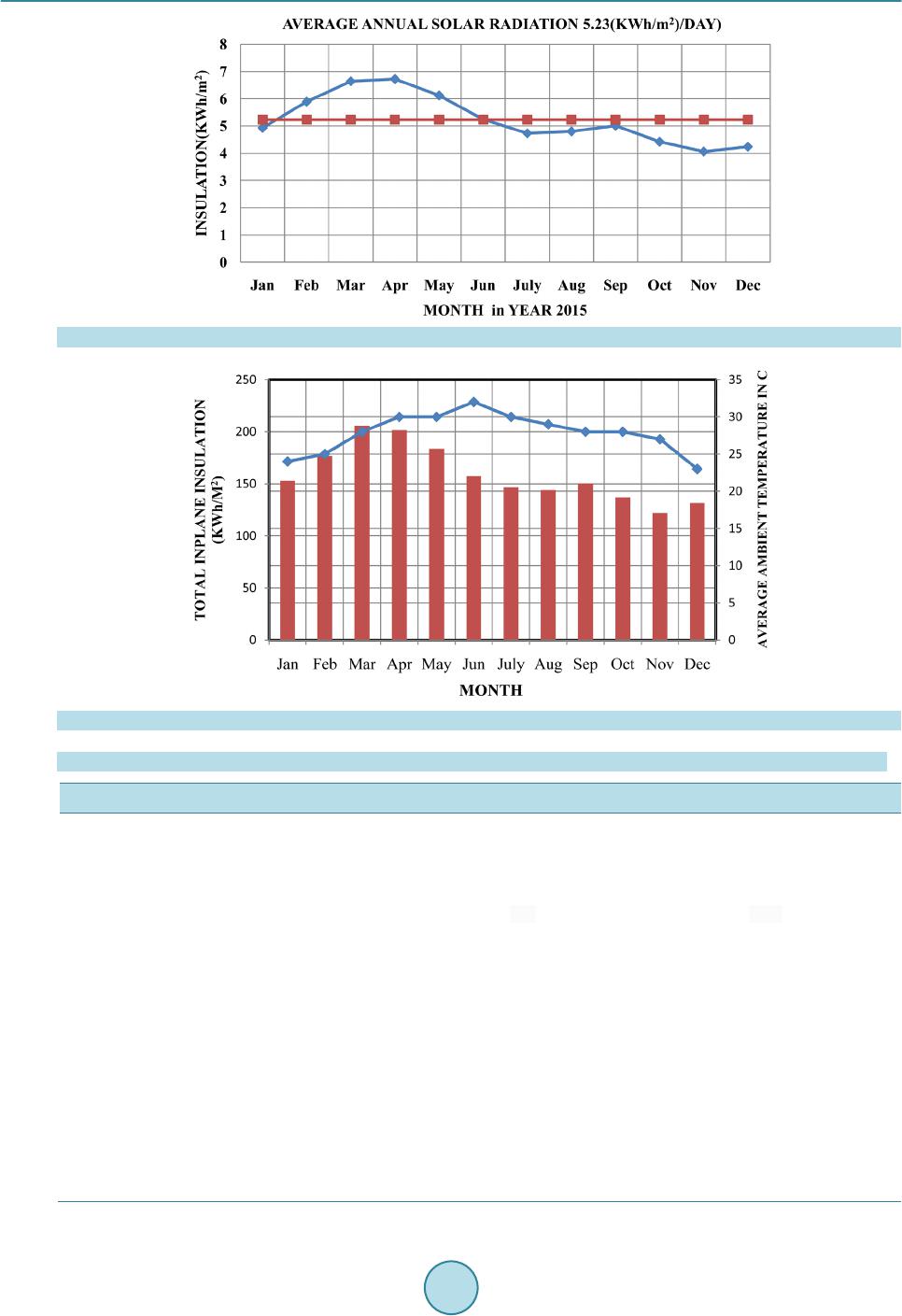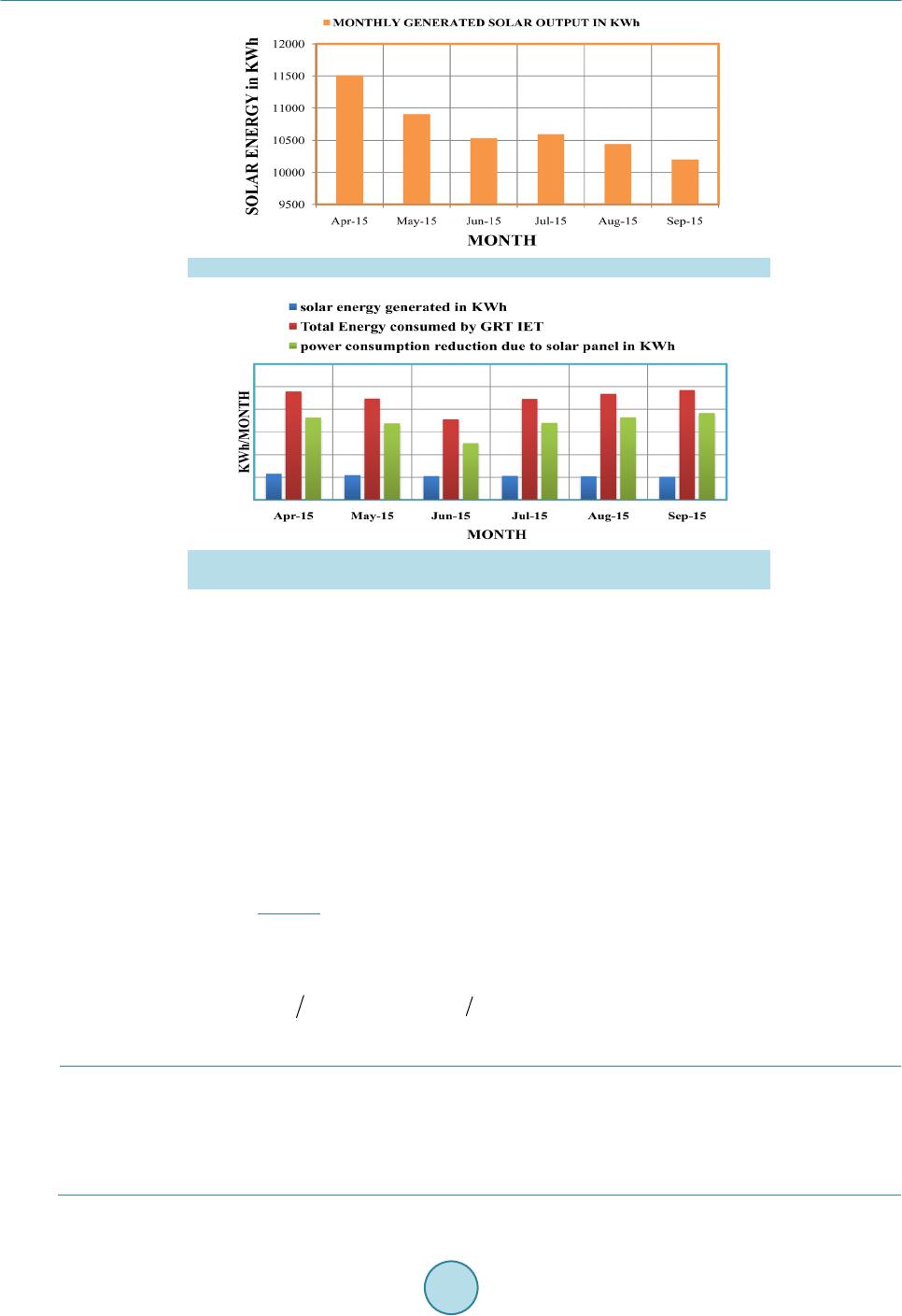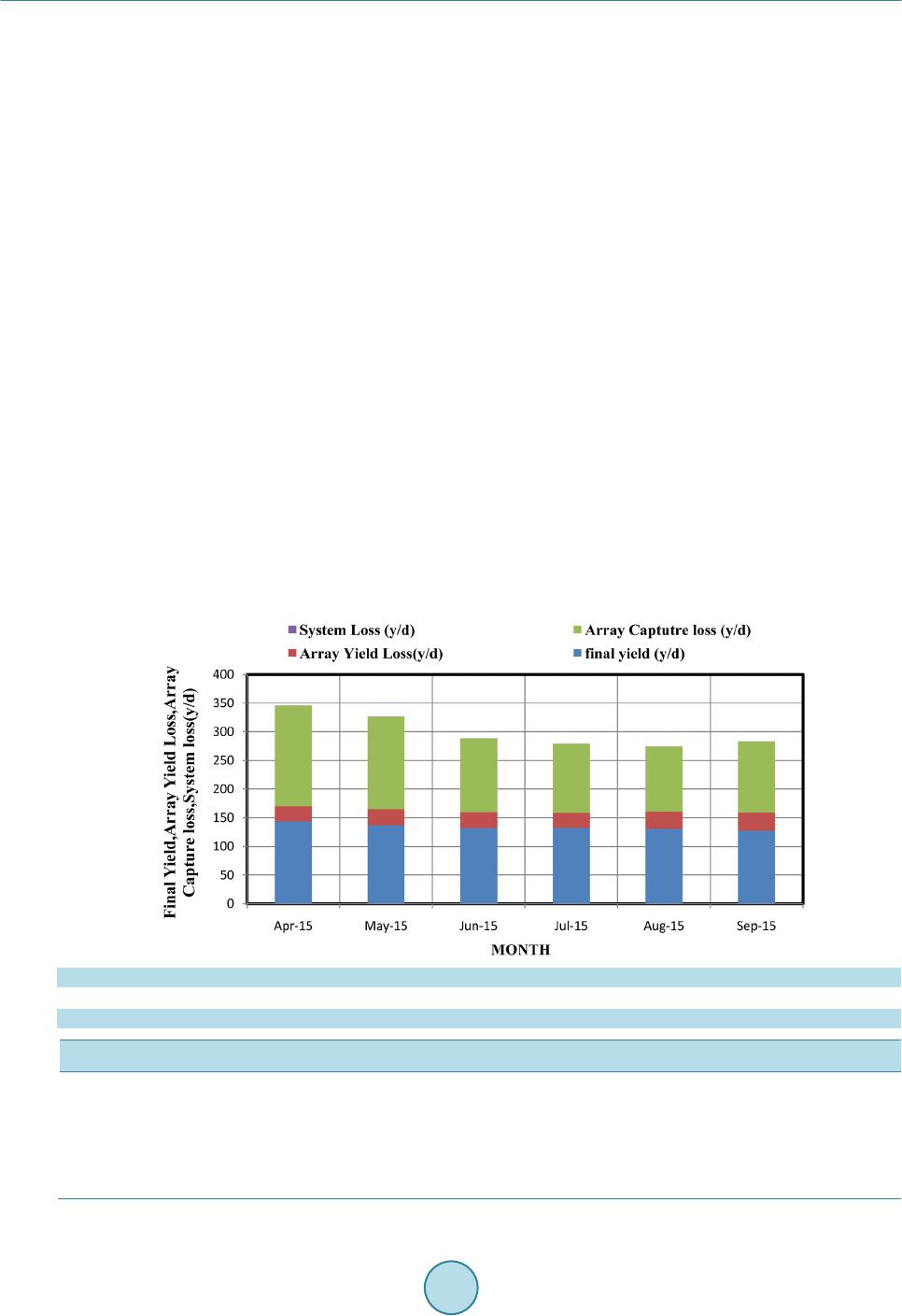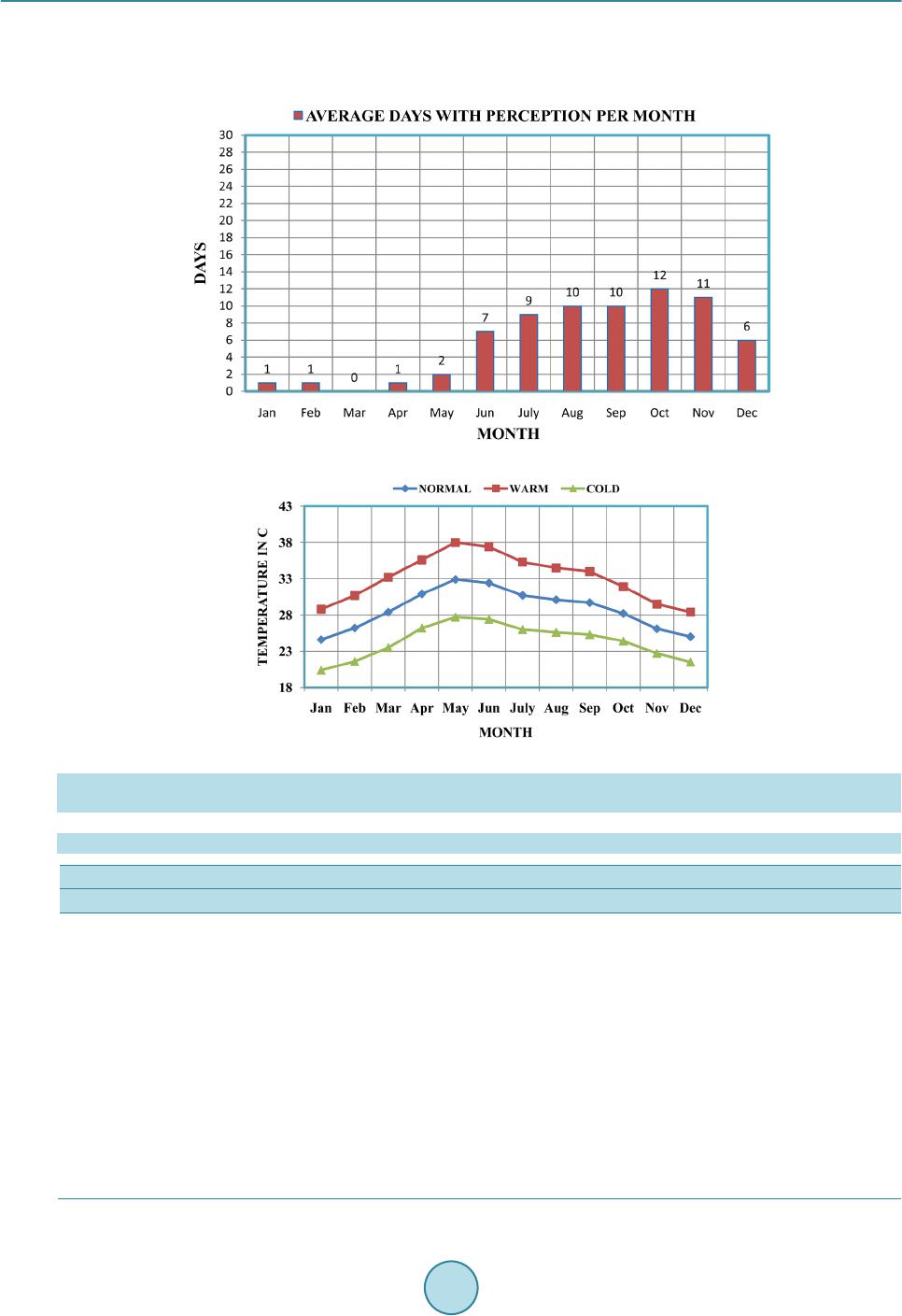 Circuits and Systems, 2016, 7, 662-679 Published Onlin e May 2016 in Sci Res. http://www.sc irp.org/journal/cs http://dx.doi.org/10.4236/cs.2016.76056 How to cite this paper: Kumar, S.S. and Nagarajan, C. (2016) Perfo rmance-Economic and Energy Loss Analysis of 80 KWp Grid Connected Roof Top Transformer Less Photovoltaic Power Plant. Circuits and Systems, 7, 662-679. http://dx.doi.org/10.4236/cs.2016.76056 Performance-Economic and Energy Loss Analysis of 80 KWp Grid Connected Roof Top Transformer Less Photovoltai c Power Plant S. Sathish Kumar1, C. Nagarajan 2 1Anna University, GRT Institute of Engineering and Technology, Thiruthani, India 2Muthayammal Engineering College, Rasipuram, India Received 16 February 2016; accepted 7 May 2016; published 11 May 2016 Copyright © 2016 by authors and Scientific Res earch Publishing Inc. This wor k is lic ensed under the Creati ve Commons Attribution International License (CC B Y). http://creativecommons.org/licenses/by/4.0/ Abstract In India most p ar t r eceive s 4 - 7 kWh of sol ar r adi at i on per square me ter per day w ith 200 - 25 0 sunny day s in a year. Tam iln adu sta te al so r eceives th e high est annu al rad i ati on in Indi a. In this paper, the grid co nnected p hotov oltai c plant has a p eak pow er of 80 KWp sup pl ies electrici ty re- quirement of G RT IET campus during day time (7 h rs) an d red uces lo ad de m and an d ge nerates useful d ata for futu re imp lement ation of su ch PV plant proj ects in the T am il n adu region. Photo- voltaic plant was inst alled in April 201 5, m onit ored during 6 mon ths, and the perfo rmance rati o and the various power lo sses (p owe r elec tronics , tem pera tu re , soil ing, i nter nal, network, grid availabili ty and interc onn ection) were calculated. The PV plant supplied 64,182.86 KWh to the grid from Apr il to September 201 5, ranging from 11,510.900 to 10,200 .9 kWh. The final yield ranged from 143.886 (h/d) to 127.51 (y/d), reference yield ranged from 201.6 (h/d) to 155.31 (h/d) and performance ratio ranged from 71.3% to 82.1%, for a duration of six months, it had given a performance ratio of 83.82%, system efficiency was 4.16% and the capacity factor of GRT IET Campus for six mon th s was 18.26%. Payb ac k peri od in years = 9 years 4 months, energy sav- ing per year = 204 ,400 KWh, cost reducti on per year = 1,737,400, Indi an rupee = 26,19 7.30 US D and tot al CO2 redu ctions p er yea r = 102,2 00 ton s CO2/year. Keywords Photo Vol t aic, Dual MPP T, Grid Conn ection, Perf orm anc e Analysis , Ener gy Loss Analysis , Economic Analysis, CO2 Reduction, Ca rbo n Credit 1. Introduction In India roof top grid connected solar photovoltaic power plant installations have been increased day b y day due  S. S. Kumar, C. Nagarajan to launch of Jawaharlal Nehru National Solar Mission (JNNSM) b y the Ministry of New and Renewable Energy India. The main idea of the Jawaharlal Nehru National Solar Mission is to achieve 20 GWp solar power genera- tion capacity by 2020. In India 30% contribution of renewable energy sources is the main energy supply and by conventional met hods the elect ricity generat i on i n India is i ncr easing continuously [1]. The role of renewable energy sources in India’s main energy supply is about 30%. By conventional and re- newable resources, the development of electricity generation in India is increasing continuously. Renewable energy increases the grid capacity by almost 4 times from year 2002 onwards. In April 2002, the installed capac- ity based on renewable energy was 3497 MW (Mega Watt) which was 3% of the co untry’s total ins talled capa c- ity. It has become 40,799 MW on 30 Nov. 2014, which is about 16% of the total installed capacity according to IEA report. The energy from sun can be utilized directly or indirectly in the form of solar energy. Solar energy plays an important role in reducing the harmful gases for environment produced during the electricity generation. Solar energy has three different technologies: solar photovoltaic produces solar power electricity, and solar cooling and heating. Based on IEA report before 2050, around 11% of the global energy demand could be satisfied by the solar energy. Internatio na l ener g y age ncy I EA re po rt in for ms b y solar photovoltaic technology could stop 100 Giga tons of CO2 emissions in the period of 2008-2050. Solar energy reduces grid transmission lines propagation cost, does not af fect the cul tiva ted land. I nternational E nerg y Agency (IEA)’s report informs that before 2050 around 11% of the global energy demand could be fulfilled by the solar energy [2]. 2. Site Detail Thiruthani is a town in the state of Tamil Nadu, India . It is located in 84 kilometer s ( 52 miles) from C hennai a nd 15 kilometers (9.3 miles) from the state of Andhra Pradesh. Thiruthani is located at 13.18˚N 79.63˚E. It has an average elevation of 76 meters (249 feet). Summers start in February and go on until early September, with av- erage temperatures around 30˚C (8 6˚F). The monsoon season starts in September only and goes on up till Octo- ber, with average rainfall and with average temperatures sliding fro m 25˚C (77˚F) to 21.5˚ C (70.7˚F). Winters start in December. The total annual rainfall is about 998 mm (39.23 in). Annual mean daily solar radiation in Thi ruthani is abo ut 5.2 3 KWh/ m2/day, and there are about 200 - 250 clear sunny da ys in a year . GRT IET has a vast amount of unused rooftop area. It can be used for the purpose, as it receives high sunshine for most of its part. It’s about 5200 sq. mts total roof top area. Figure 1 shows the Google map GRT institute of engineering technology location in Tamilnadu state. 2.1. Photovoltaic Plant Details This plant is co mprised o f Vicr a m Solar Eldo ra 250P mono crystalli ne silic on P V modules. T he P V modules are arranged in par allel strings 80 modules each, with total 320 modules and connected in 4 Conext CL20000 E in- Figure 1 . Location of Thiruthani in Tamilnadu state.  S. S. Kumar, C. Nagarajan verters installed with supporting structure, plus connection boxes, irradiance and temperature measurement in- strumentation and d ata loggin g system. The transfor mer less inverters are tied to the national grid via a 440V/11 kV transformer with electrical energy meter. T he solar PV system is mou nted on a stai nless steel support struc- ture facing south and tilted with an angle of 30˚. Such a tilt angle was chosen to maximize yearly energy pro- duction. Figure 2 sho ws the GRT IET PV plant. Table 1 shows PV plant detail [2]. 2.2. Transformer Less String Inverter Three phase transformer less grid tied string inverter designed for high efficiency, easy installation and maxi- mum yield. The inverter c onverts the solar electr ic (photovoltaic or PV) power into utility grad e electricity. T he inverter is designed to collect maximum available energy from the PV array by constantly adjusting its output power to track maximum power point (MPP) of the PV array. The inverter has two MPPT channels (MPPT1 and MPPT 2). A maximum of four string inputs can be connected to each independent MPPT channels. The two in- dependent PV arrays can operate at different peak power points, to capture the maximum possible energy. The inverter accommodates PV arrays with open circuit voltages up to maximum of 1000 VDC. This inverter is a transformer less design and therefore has no galvanic isolation. This proposed grid tied power plant paper presents the new design, development and performance analysis of a grid connected PV inverter. Figure 3 sho ws the block diagram of the Conext CL 20000E inverter model. The key features of Conext CL 20000E inverter is shown in Table 2 and Table 3 show the inverter details. Figure 2 . Capture of PV plant at GRT IET. Table 1. PV panel details. Model name Vicram Solar Eldora 250P Rated peak power (Pmpp) 250 W Open circuit v o ltage (Voc) 37.55V Rated cu rrent(Isc) 8.71 A Type Mono crystalline No of modules 320 Nos No’s of modules per KW 4 Nos Detail of series/parallel combination 12 × 25 nos in series and parallel str ing Fill factor 76.48% Efficiency 15.53% Temperature Min 1 5 degre e and max 45 deg r ee centig r ade Dimensions of single module (mm) 1639X36 m m  S. S. Kumar, C. Nagarajan Figure 3 . Block diagram of the context CL 20000E inverter model. Table 2. Features of transformer less inverter The Key Features of inverter • Power rating: 20 kVA (1000 VDC systems) • PV compatibility: Designed to work with Mono- Crystalline or Poly- Crystalline panel • Three-phase (3-Phase + N + PE [gr ound]), four wires, grid-tie, transformer less • Wide MPPT voltage range • 350 - 800 VDC for 20 KVA • Supp orts high array to inverter ratio (over- paneling) • Two indepen de nt MP P Trackers w ith op tion to combine togethe r • En ergy h arvest (MPPT) effi ciency: >99 % • Fast sweep MPPT tracking • Maximum power conversion efficiency: >9 8% • Power factor adjus t m e nt range : 0.8 ca pacitiv e to 0.8 i n ductiv e • Low AC output current distortion (THD < 3%) @ nomin al power. Key featu res o f inv ert e r cont in ues from Table 1 IP65 (electronics)/IP54 (rear portion) protection class for installation in outdoor environments • −25˚C to 60˚C Operating temperature range • Flexible installation: Inverter and wiring box separable installation • Dry Contac t ( M ulti function) r elay • Remote Power off (RPO) • Modbus RS485 and Modbus TCP commun ications • USB host for local firm ware upgrade • Custom data Loggin g ( User configurab le) • 3” (diagonally) graphical display (LCD) with integrated 7- button control panel • Embedd ed Web s erver via Ethernet (TCP/IP)  S. S. Kumar, C. Nagarajan Table 3. Inverter detai ls. Device name Conext CL20000 E El ectri cal specif ications Input DC Full power MPPT voltage ran ge 350 - 800 V Operating voltage range at nominal AC volt age 250 - 1000 V Max. input voltage, open circuit 1000 V Number of MPPT/strings per MPPT 2 Max. DC in p ut c ur r ent per MPP T 31 .0 A Max. array short circuit curren t per MPPT 40.0 A Nomin al DC input power 21.5 KW Max. DC input power per MP PT 12.9 Kw Output (AC) Rated out put power (PF = 1) 20.0 kW Max. apparent power 20.0 kVA Nomin al output voltage 230/400 V AC voltag e range 184 - 276 V/319 - 478 V Frequency 50/60 Hz Frequency range (adjustable) 50 +/− 3 Hz, 60 +/− 3Hz Max. output current 30.0 A Nominal continuous output current 29 .0 A Total harm o ni c distor tio n <3% Power factor (adjustab le) 0 .8 lead to 0. 8 lag Efficiency Peak 98.3% 3. Solar Radiation and Insulation Analysis Solar radiations were collected from the different places in plant to estimate the solar radiation the incident global irradiance of array plane in plant cell, the ambient temperature of PV cell, the DC output power of each array and the AC output power of PV plant of GRT IET were measured for every 5 min and stored in the custom data logging system and also embedded Web server via Ethernet. The monthly AC output energy generated at the grid was stored in internal custom data logging system. Figure 4 shows the monthly averaged solar radian and Figure 5 shows the total in-plane i nsulation to gether with the monthl y ambient temperature averaged over the daytime hours in the year 2015. The highest value of total in-plane insulation was in March with 205.886 kWh/m2 and the lowest in November was 121.88 kW h/m2. T he annual i nsula tion wa s 190 8.96 kW h/m2, and the mean ambient temperature was 33.10˚C [3]. The average insulation data for Thiruthani is prese nted in the Ta ble 4 belo w. Since the peak power output of solar modules is delivered at STC of 1000 W/m2 ins ula t io n, t he a ctual p ower o utp u t d ep e nds upo n t he i ns ula ti o n at the place. 3.1. Performance Evaluation Methodology As per IEC standards the following main parameters are evaluated to find the PV system performance:  S. S. Kumar, C. Nagarajan Figure 4. Average solar radiations in KWh/M2 in year 2015. Figure 5 . Mo nthly average in plane insulation in (KWh/m2) and ambient temperature in ˚C over the year 2015. Table 4. Monthly averaged insulation level (Kwh/m2). Sl no Month Insulation (kWh/m2/day) Insulation (kWh/m2/month) 1 January 4.93 152.83 2 February 5.89 176.7 3 March 6.64 205.84 4 Apri l 6.72 201.6 5 May 6.12 183.6 6 June 5.24 157.2 7 July 4.73 146 .63 8 August 4.80 144 9 September 5.01 150.3 10 October 4.42 137.02 11 November 4.06 121.8 12 December 4.24 131.44 Yearly average 5.23 1908.9  S. S. Kumar, C. Nagarajan 3.1.1. Final Yield (YF) The total energy generated b y the PV plant for a particular period (E) divided by the rated output power gener- ated (PPV, Rated) of the installed PV system is called the Final yield (YF), at the standard test conditions (1000 W/m2 irradiance, 25˚C ambient temperature and air mass 1.5 g) (1) 3.1.2. Reference Yield (YR) Reference yield is defined as the ratio of total in plane solar insulation (Ht) (kW h/ m2) to the reference irradiance (G) (1kW/m2). (2) 3.1.3. Performance Ratio (PR) Performance ratio (PR) is defined as the ratio of the final yield (YF) to the reference yield (YR). Performance ra- tio is dimensionless quantity and it is normalized to performance parameter w.r.t incident solar radiation. It shows the overall effect of losses. This parameter is used to evaluate the long ter m changes in the perfor mance of PV plat. Performance ratio PR values indicate the loss in the performance of the system year wise. (3) 3.1.4. Capacity Factor (CF) The capacity factor (CF) is defined as the ratio of actual annual energy generated by the of the PV plant in- stalled (EAC,a) to the a mou nt of PV s ystem ener g y generate if it op era tes at full rate d p o wer (P PV, rated) fo r 24 hour per day for year and is given as: (4) 3.1.5. System Efficiency System efficiency is defined as the ratio of the energy generated (EAC, D) to the incident irradiance (Ht) at the module area (Aa) give n as: (5) The efficiency of the system: (6) where Pmax = Maximum Power generated i.e. multiple of maximum current (Imax), maximum voltage (Vmax) & Fill Factor (FF), Ht = Incident irradiance, Aa = Module area. () () max maxscoc FF VIIV∗= ∗ (7) The above performance parameters provide the overall system performance with respect to energy production, solar resource, and overall effect of system losses. 3.2. Factors Affecting the Pe rf ormance of PV M od ule 3.2.1. PV array R ati ngs PV arrays are rated under standard conditions as listed below: • Specified illumination (1000 W/m2), • Spectrum o f the li ght, • Specified temperature (25 ˚C/77˚F). This is called the Standard Test Condition (STC) rating and is the figure that appears on the PV module na- meplate label.  S. S. Kumar, C. Nagarajan 3.2.2. Expected Performance Due to several unavoidable environmental factors, a PV array produces only around 60% to 70% of its peak STC-rated output for a well designed and installed PV system on a typical d ay. 3.2.3. Temperature and Reduced Output The PV array temperature affects the output of the entire system. As the temperature of the array surface rises, its energy output decreases. The arrays mounted on roof also collect the heat generated by the roof surface (or trapped under the array) and will produce less output than pole-mounted arrays, which allow greater air circula- tion behind the panels. 3.2.4. Partial Shade The shading o f even o nly a si ngle mo dule o f the arr ay red uces t he output of the entire s ystem. For example, the shadow is cau sed by a utility wire or tree branc h on a porti on of the array’s surface. Partial shading reduces the total output. 3.2.5. Other Factors Other factors that contribute to system losses are: • D ust o r d irt on the array, • Smog or Fog, • Mismatched PV array modules, with slight inconsistence in performance from one module to another, • Wire losses , • Utility grid voltage. 3.2.6. Performing General Maintenance The simpl e routine s ensure l ong ye ars of service and optimal performance of the inverter and PV system. • Keep ing the unit a way fro m dust and de bris , • Cleaning the PV array under non-illuminated conditions whenever it is visibly dirty, • Periodica lly inspecting the system to make s ur e that all the wiring and supports are securely in place, • Maintaining a log of system performance readings so that PV p lant performance becomes analyzed periodi- cally. 4. Total Output The average Energy generated fro m photovoltaic power plant are tabulated on daily basis and here the average 6 month energy output is calculated by multiplying average monthly energy output with total number of days for 6 month. Kilo watt-Ho ur ( kW h) mea ns 1 0 00 watt s c ons u med fo r a p er io d o f 1 hour and kW h is a uni t o f ene r g y [1 kWh = 3600 kJ]. Table 5 shows t he Mont hly Genera ted Ou tput in kWh. Fi gure 6 shows the Si mulink mod el of Mo nthl y gen- erated output in kWh. Figure 7 shows the monthly averaged solar energy generated, total load consumed and power reduced due to solar panel in plant. Table 5. Monthly generated output in KWh. Month Sola r panel monthly output generate d in KWh Total load consumed GRT IET in KWh Load consumption reduced by solar panel in KWh April 2015 11,510.9 47,941.9 36,431 May 2015 10,907.69 44,688.69 33,781 June 2015 10,532.57 35,682.57 25,150 July 2015 10,592.9 44,592.0 34,000 August 2015 10,437.9 46,967.9 36,530 September 201 5 10,200.9 48,568.30 38,367.40 Total 64,182.86 26,8441.36 204,259.40  S. S. Kumar, C. Nagarajan Figure 6 . Monthly generated output in KWh. Figure 7. Monthly averaged solar energy generated, total load consumed and power reduced due to so lar panel. 5. System Analysis The PV plant system in GRT IET was fully monitored to assess the performance of the system with the local power grid. PV plant performance is evaluated by using the parameter final yield (YF), reference yield (YR), performance ratio (PR) and the capacity factor (CF) was calculated as per IEC Standard 61724 [4]-[6]. The final yield is defined for 6 month AC energy output of the system divided by the peak power of the in- stalled PV array at standard test conditions (STC) of 1000 W/m2 solar irradiance and 25˚C cell temperature. 5.1. System Performance Analysis The performance of solar photo voltaic power plant is a function of climatic conditions, equipment used and system design. The main parameters for evaluation of solar photo voltaic power system performance as per In- ternational E nergy Agency (IEA) Standards are as follows. 5.1.1. Final Yield, where E= total energy ge nerated by the PV s ys tem, for six months in GRT IET i. e . 64182.86 KWh. P = the rated output power of the in stalle d PV system i.e. 80 kW. Then, () ( )( )() F Y64182.86 kWh80 kW802.285 hd6month= = The final yield for a ll 6 months is given be l ow 11510.9/80 = 143.886 (h/d) 10907.97/80 = 136.34 (h/d) June month YF 10532. 57/80 = 131.657 (h/d) 10592.90/80 = 132.411 (h/d) F 10437.9/80 = 130. 47 (y/d) 10200.90/80 = 127.51 ( y/d)  S. S. Kumar, C. Nagarajan 5.1.2. Reference Yi eld, where,Ht = total in plane solar insulation in (kWh/m2) i.e. 5.23 kWh/m2/day (A verage) . G = the reference irradiance i.e. 1kW/ m2. Then, ( )( )() R Y5.231831957.09hdfor 6 months=×= The reference yield for all 6 months is given below. April month YR (6.72 × 30)/1 = 201.6 May month YR (6.12 × 31)/ 1 = 189.7 2 June month YR (5.24 × 30)/1 = 157.2 July month YR (4. 73 × 31)/1 = 146.63 August m onth YR (4.80 × 30)/1 = 144 September month YR (5.01 × 31)/1 = 155.31 5.1.3. Performance Ratio, Then, ( ) PR802.285 957.090.838= = (6 month). Hence, the performance ratio o f GRT IET campus for six months is 83.82%. April mon th PR 143 .886/201 .6 = 0.713 May month PR 136.34/189.72 = 0.718 June month PR 131.65 7/157.2 = 0.837 July month PR 132.411/146. 63 = 0.903 August m onth PR 130.47/144 = 0.906 September month PR 127.51/155.31 = 0.821 5.1.4. Capacity Factor, But we can measure t he CF for s ix months ( i.e. 183 days). Then, () CF64182.86 8043920.1826= ×= . Hence, The capacity factor of GRT IET Campus for six months is 18.26%. The capacity factor for all 6 months is given bel ow. April mon th CF 11550.9/(80 × 720) = 0.20 = 20.05% May mo nth CF 10907.69/ (80 × 744) = 0.183 = 18.32% June month C F 10532. 57/(80 × 720) = 0.182 = 18.l28% July month C F 10592.9/(80 × 74 4) = 0.177 = 17.797% August m onth CF 1043 7.9/(80 × 72 0) = 0.181 = 18.12 % Sep te m ber month CF 10200.9/(80 × 74 4) = 0171 = 17.131% 5.1.5. System Efficiency, where EAC = total energy generated by the PV system, for six mo nths in GRT IE T i.e. 64 ,182.86 kWh.  S. S. Kumar, C. Nagarajan Ht = total in plane solar insulation in (kWh/m2) i.e. 5.23 kWh/m2/day = 9547.09 kWh/m2. Aa = Module area in (m2) i.e. 1609 m2. The n, ( ) sys,m 64182.86 957.09 16090.04164.16% η =×= = The System efficiency for all 6 months is give n below. April month ηsys 11510.9/(201.6 × 1609) = 0.0354 = 3.54% May month ηsys 10907.97/(189.72 × 1609 ) = 0.0329 = 3.29% June month ηsys 10532. 57/(157. 2 × 1609) = 0.0416 = 4.16% July month ηsys 10592. 90/(146. 63 × 1609) = 0.0448 = 4.448% August m onth ηs ys 10437.9/ (144 × 1609) = 0. 0448 = 4.48% September month ηsys 1 0200.90 / (155.31 × 1609 ) = 0. 0408 = 4.08% System efficiency for 6 month is 4.16 %. Table 6 shows the overall performance of GRT IET power plant in Thiruthani. Figure 8 monthly averaged final yield, reference yield, performance ratio, and capacity factor and system efficiency in (y/d). 5.2. Loss Analysis The performance ratio of PV system is the final yield d ivided b y the reference yield; it rep resents the to tal losses in the system when converting from name plate DC rating to AC output. The typical losses in GRT IET plant includes losses due to panel degradation (ƞdeg), temperature (ƞtem), soiling (ƞsoil), internal network (ƞnet), in- verter (ƞinv), and system availability and grid connection network (ƞppc) [6]. While the array yield (YA) is defined as the annual or daily energy output of the PV array divided by the peak power of the installed PV, the system losses (LS) are gained from the transformer less inverter, and the array capture losses (LC) are due to the PV array losses. Figure 8. Monthly averaged final yield, reference yield, performance ratio, and capacity factor and system efficiency in (y/d) . Table 6. Six month performance report of GRT IET. Sl No Name of performance Value (6 month) 1 Fina l yi eld 802.285 (h/d) 2 Reference yield 957.09 (h/d) 3 Performan ce ratio 83.82 % 4 Capacity factor 18.26 % 5 System effic i en c y 4.16 %  S. S. Kumar, C. Nagarajan (8) (9) (10) 5.2.1. Monthly Array Yield Loss Mont hly array loss ( ) A AR E Y64182.86 444144.55hd P = == (6 month). The mon thly array yield loss for all 6 months is given belo w. April month YA 11 ,510.90/444 = 25.925 (h/d) May month YA 10,907.97/382 = 28.55 (h/d) June month YA 10,532.5 7/378 = 27.86 (h / d) July month YA 10,592.90/413 = 25.64 8 (h/d) August m onth YA 10,437.9/340 = 30.699 (h/d) September month YA 10,200.9 0/329.0 6 = 31.0012 (h/d) 5.2.2. Monthly Array Capture Losses Monthly array capture losses ()( ) R A Y957.09 4.55812.53hd6month Y= = . The monthly ar ray capt ure loss for all 6 months is given bel ow. April mon th Lc 201.6 - 25.925 = 175.65 (h/d) May month Lc 189.72 - 28.55 = 161 .17 (h/d) June month Lc 157.2 - 27.86 = 129.34 (h/d) July month Lc 146.63 - 25. 648 = 120.98 (h/d) August m onth Lc 144 - 30.699 = 113.301 (h/d) September month Lc 155.31 - 31.0012 = 124.309 (h/d) 5.2.3. Mo nth ly System Losses Mont hly s ystem los s es ( )() S L144.55802.2850.181hd6month = = . The monthly system loss for all 6 months is given b elow. April mon th LS 25.925/143.886 = 0.18 (h/d) May month LS 28.55/136.34 = 0.2090.18 (h/d) June month LS 27.86/131. 657 = 0.2110.18 (h/d) July month LS 25. 648/132.411 = 0.1930.18 (h/d) August m onth LS 30.699/1 30.47 = 0.2350.18 (h/d) September month LS 31.0012/127.51 = 0. 243018 (h/d)  S. S. Kumar, C. Nagarajan The incident global irradiance of PV plant in the array plane, the ambient temperature o f PV cell , the DC ar- ray output power of each cell and the PV plant of GRT IET AC output power were measured every 5 min and stored in custom data logging system and also embedded Web server via Ethernet. Figure 9 s hows t he M ont hly averaged final yield, array yield loss, array capture loss and system loss in (y/d). Table 7 gives r ecordi ng cycle for the PV pla nt in stalle d. Figure 4 sho ws the mo nt hl y a ver a ged to ta l i n-plane i ns ulat i o n to get her with t he mont hl y a mbie nt t e mper a t ure averaged over the daytime hours. The highest value of total in-plane insulation was in March with 205.886 KWh/m2 and the lowest in November was 121.88 KWh/m2. The annual insulation was 1908.9 6 kWh/m2, a nd the mean ambient temperature was 33.10˚C [7] . The PV plant generated 64182.86 KWh in 6 months, Figure 9 shows the monthly averaged array capture losses and system losses. The monthly averaged array yield ranged from 802.285 (h/d) (April) to 127.51 (h/d) (September), the average 6 month final yield and the reference yield were 802.285 (h/d) and 957.09 (h/d) re- spectively. The monthly averaged array losses ranged from 175.65 h/d (April) to 124.309(h/d) (September), and the s ys te m l os se s r an ge d fr om 0.18 (h/d) (April) to 0.2430.18 (h/d) (September). The performance ratio was dis- tributed within the range of 71.3% - 82.1%, and 6 month mean value was 83.82%. The total final yield was 802.285 (h/d). The average capacity factor was 18.26%. The method followed to calculate the various losses of the PV plant can be described as follows; the ambient daytime temperature, the in-plane solar radiation, the array DC power and the PV plant AC output power are calc ulated wit h an ever y 5 min frequenc y duri ng a typ ical d ay per mo nth. T he nominal i nstanta neous ar ray DC output power per every 5 min and the total array output energy are calculate d using the s olar radia tion data and the technical specifications of the photovoltaic panels used in plant. The real PV array output power is simulated gradually by adding the various losses of the array; temperature and the soiling losses, degradation modulus losses. The efficiency of a PV panel depends on the operating temperature and the power density of the solar radiation. If temperature of the PV panels increases the efficiency of the PV power panel decreases linearly, since the peak power of the PV panels refers to STC conditions. In different temperatures variation the output power of the PV panels depends on the difference of the PV panel temperature, the standard STC temperature Figure 9 . Mo nthly averaged final yield, array yield loss, arr ay capt ure loss and system loss in ( y/d). Table 7. Recording cycle and storage time fo r PV system. Recording Cycle Storage Time 1 record/5 minut e 1 day 1 record/15 minutes 1 month 1 reco r d/1 day 1 year 1 record/1 month 10 year s  S. S. Kumar, C. Nagarajan (TC-TSTC) and the power density (G) of the incident solar radiation. The PV module monthly operating temper- ature, ambient temperature variation and perception per month are measur ed and monito red is shown in Figure 10(a) and Figure 10(b). Table 8 shows the temp erature variation per month in year 2015. (a) (b) Figure 10. (a) Average precipitation variation per month in year 2015; (b) Average temperat ure variat ion per mont h in year 2015. Table 8. Te mperature variation and perception per month. Temperature Precipitation Months Normal Warmest Coldest Normal February 26.2˚C 30.7˚C 21.6˚C 1 March 28.4˚C 33.2˚C 23.5˚C 0 Apri l 30.9˚C 35.6˚C 26.2˚C 1 May 32.9˚C 38.0˚C 27.7˚C 2 June 32.4˚C 37.4˚C 27.4˚C 7 July 30.7˚C 35.3˚C 26.0˚C 9 August 30.1˚C 34.5˚C 25.6˚C 10 September 29.7˚C 34.0˚C 25.3˚C 10 October 28.2˚C 31.9˚C 24.4˚C 12 November 26.1˚C 29.5˚C 22.7˚C 11 December 25.0˚C 28.4˚C 21.5˚C 6  S. S. Kumar, C. Nagarajan In summer the monthly average ho urly PV module te mperature varied wit hin 37.4˚C to 28.4˚C, and the am- bient temperature ranged between 34.5˚C and 30.7˚C. In winter, the average hourly PV module temperature ranged between 31.9˚C and 28.4˚C. The temperature losses coefficient (ƞtem) can be calculated as (11) where β is the temperature factor o f the PV module. The PV cell temperature (TC) is corre lated with the air tem- perature (Ta) as follo ws ( )( ) c aNOCTaNOCT NOCT GG TTT20TT 20 G 800 =+−=+ − (12) where nominal temperature NOCT (45˚C) is the operational cell temperature and G is the power density at the particular time. The coefficients of temperature losses were calculated with every 5 min frequency and the an- nual losses were calculated and summed to 7.12%. The PV panel’s continuous operation normally covered with a fine layer of dust and dirt, decreasing the amount of light fall on each PV cell. The amount of power loss due to soiling (ƞsoil) depends on the type of dust, last rainfall and the cleaning maintenance schedule of the PV module in plant. In GRT IET power plant the monthly coefficients were empirically estimated based on the rainfall data of the site. The soiling losses were calculated 5% - 6% during the winter and 7% - 8% during the summer period in the year, resulting in annual losses at 6.5% in 2015. A 5% mismatch of power loss due temperature and soiling losses with the real recorded output power was obs erved in o ur plant. This mismatch can be considered with PV panel degradation losses (ƞdeg) due to ageing of plant; this is in full agreement with experimental studies and manufacturers declarations and warranties, whereas the initial power declar ations lie at 5% with a lifetime maximum of 20%. [ ][] PVrP2 kW PkWP kWGm =⋅ (13) The transformer less inverter conversion losses were calculated with a 5 min frequency by subtracting the ar- ray DC output power fro m the AC outp ut power a nd by nor malizing the DC wiring and interconnection losses (ƞnet = 6%) and Finally, the monthly availability and national grid connections losses (ƞppc) were calculated as the ratio of the sold e nergy to the grid divided by the AC overall o utput energy of the plant ar e shown in Figure 7. The availability and grid connection losses (ƞPPC) range from 0.3 (April, May) to 19.9% (September), with an annual average of 4.54%. The losses are very low (<1%) in March, April, may and June and there is an increase from august, September. The various 6 month losses of the PV Plant can be summarized in Table 9. Table 9. Average power loss in solar panel. In plane irradiance 1908.96 kWh/m2 Effective irradiance on PV panel at GRT IET 1908.9 6 kWh/m2 * 1369 m2 PV conversi on Efficie ncy at 15.53% Array nominal energy (at STC ) 12,088.45 KWh PV degradation l o sses 5% Temperature losses 7% Soiling losses 4.26% PV array energy 74,349.0 03 KWh Internal network losses 5% Inver ter losses 6.84% Availability &grid connection losses 4% Delivery to grid 64,182.86 KWh  S. S. Kumar, C. Nagarajan 6. Economic Analysis Four methods are considered for financial analysis of the power project via (i) pre-tax scenario, (ii) post-tax scenario, (iii) pr e-tax with equity and (iv) post-tax with equity for both on-site and of f-site options. T he financial analysis of plant is considered for 25 years of plant life. In pre-tax scenario financial performances for the project work are determined without considering the tax and duties. For post-tax scenario 0% tax is taken for first 10 years and 4% afterwards is specified for the solar power plant in Tamilnadu. Also, 7% depreciation is considered for first ten years and 1.33% afterwards. The cost analysis is based upon the following factors [8]. 6.1. Cost of Inverter The cost of the three phase transformer less inverter is shown in Table 10. Inverter cost includes wiring box, wiring box mounting bracket, Relay and RPO connector, Modbus RC terminator RJ45 plug. 6.2. Cost of PV System The cost of the rooftop solar photovoltaic panel is shown in Table 11. The cost includes total cost of 80KW p PV panel with subsidy. 6.3. Total Cost The total cost of whole plant including inverter and PV panel and operation and maintenance cost is shown in Table 12. 6.4. Per Unit Energy Cost Our GRT Institute of Engineering and Technology installed PV system life is 25 years. So, the cost per unit of energy by the designed system will be: Total cost of the system: 70111.335 $ (USD), Average dail y bright sunshine hours: 7, Table 10. Cost of the inverter. Cost of 3 Phase transformer less Inverter 20 KW 4648 U SD 30,616,585 .00INR Size of Inverter 80 KW 18592 USD 1,224,663.41INR Table 11. Cost of the solar panel plant. Cost of 250Wp roof top Solar Photo-Voltaic 1 230 USD 15,150.00 INR Cost of 80kWp roof top Solar Photo-Voltaic 320 7 3599.039 US D 4,848,00 0.00 INR Subsidy @30% 0.3 22079. 712 USD 1,454,400.00 INR Net Cost after Subsidy 51519.328 U SD 3,393,600.00 INR Accelerated Depreciation @80% 0.8 41215.462 USD 2,714,880.00 INR Tax Rate @35% 0.35 18031.765 USD 1,187,760.00 INR Tax Saved through Accelerated Depreciation 31929.656 USD 2,103,220.00 IN R Table 12. Total cost of the whole plant installed. Total cost wi thout battery INR USD Net cost af ter subsidy (SPV-PANELS) 3,393,600.00 Total Cost for 3 Phase Inverter 1,224,663.41 Net Cost for whole set up 4,618,26 3.41 70111.335  S. S. Kumar, C. Nagarajan Estimated capacity of the designed system in kW: 80, Avg. energy produced per day in kWh: 80*7 = 560 W, Energy produced in 25 years in kWh: 560*25*365 = 5,110,000 KWh, Cost per unit = 8.5 rupees (0.103 USD), Total cost reduced by solar energy in 25 year = 4, 34, 35,000 Indian rupees = 654,932.48 USD. 6.5. Environmental Impacts of Solar Power 6.5.1. Benefits under Carbon Credit Carbon separation can provide a country wit h both monetary and non monetary benefits. Currently carbon cre- dits are valued at approximately € 30 per metric ton. Even if a country generates 100,000 metric tons of carbon credits in year it can generate an additional € 3 million which is a q uite significa nt amount espe cially for a deb t rid den country like India. Currently, there are only about 225 projects in India which are moving towards taking advantage of this car- bon credit concept to the current global requirement of 350 - 500 million tones of additional carbon credits. 6.5.2. Environmental Impacts Be fore developing of any new technology we need to consider the following impact on environment. 1) Land use Solar systems can be minimized by placing them at lo wer-quality locations such as bro wn fields, abandoned mining land and transmission corridors. Smaller scale solar PV panels can be built on homes or commercial buildings, also have minimal land use impact. 2) Water use Solar P hoto voltaic cell does not use water for generating ele c tricity. 3) Hazardous materials The phot o voltaic cell manufacturing industries uses a number of hazardous materials. most of th em are used to clean and purify the semiconductor surface, These chemicals are similar to used in the general semiconductor industry, include 1,1,1-trichloroethane, acetone ,hydro chloric acid, sulfuric acid, nitric acid, and hydrogen fluo- ride. 6.6. Latest Technology Development 6.6.1. Advances in Solar Cell Technology The new technology is in solar cell by Light-Sensitive Nano particles and Gallium Arsenide. Light-Sensitive Nano particles increase radiant light absorption in Panels up to eight percent more efficient at converting sun- light. Galliu m Arsenide mode l of PV cell uses a se nsor-dri ven windo w blind t hat ca n trac k sun l ight alo ng wi th “light-pipes” that guide the lig ht in to the system 6.6.2. Molten Salt Storage By using Molten Salt Storage Technology solar plants can operate at temperatures over 500 degrees Celsius, it resul t s in a much hi g her p o wer out p ut. D ue t o Mo lt en Salt Sto rage T ec hnology costs to stor e solar power will be reduced significantly and companies will finally use solar power plants as base load plants. 6.6.3. Solar Panel with Built-In Battery Solar P a nel with Built-In Battery technology is rechargeable battery is built into the so la r panel itself, ra ther than operating as two standalone systems. By combing the two methods into one system costs will be reduced by 25% compared to existing products. 6.7. Advances in Solar Cell Manufacturing Magnesium Chloride-Thin Film Technology Thin film technology is the next generation of solar panels with narrow coatings of cadmium telluride in solar cells. This technology promises to be a much cheaper and more efficient way to commit the photovoltaic process. Magnesium chloride is found fro m seawater, an abundant resource, which makes the resource very low cost, as well as non -toxic, due to thin film technolog y increa se in efficiency of solar cells from 2% to up to 15%.  S. S. Kumar, C. Nagarajan 6.8. New Solar Applications Roads with Solar Panels Solar panels on Roads are used to reduce large amounts of electricity to the grid. This solar panel on road will help to reduce the major b ar r ier to industrial scale alread y so lar ro adways have been used in Netherlands. 6.9. Solar Plants on the Wate r Another method to erect solar plants on the water, since over 70% of the Earth’s surface is covered in water. 6.10. Space-Based Satellites From sunlight Space-based satellites capture and convert the microwave energy into electrical energy. These types of space-based satellite technologies surely capture nearl y ninety percent of sunlight. Indi a, Chi na and Ja- pan are investing heavily in space based technologies right now. 7. Conclusions The performance analysis of a grid connected PV system in Tamilnadu Thiruthani GRT IET has been investi- gated. The following c onc lusions can be dra wn: - Average 6 month PV plant energy output in 2015 is 64,182.86 KWh. - Average 6 month performance ratio of the plant is 83.2%. - The average 6 month capacity factor is 18.26%. - Energy saving per year = 204,400 KWh. - Payback period in years = 9 years 4 months. - Cost reduction per year =17,37,400 INR = 26,197.30 USD. Tota l CO2 Reductions per year = 102,200 tons. CO2 sho ws t he sol ar P V s ystem i nsta l led in GRT IE T Ca mpus is eco-friendly and good for enviro nment. References [1] (2010) Jawaharlal Nehru National Solar Mission . Guidelines for Selection of New Grid Connected Solar Power Projects. www.mn re . g ov. in [2] Ministry of Po we r , Government of India, Central Electricity Authority. http://www.cea.nic.in/reports/monthly/xecutive_rep/Nov14.pdf [3] Besarati, S.M., Padilla, R.V., Goswam i , D.Y. and Stefanakos, E. (2013) The Potential of Harnessing So lar Radiati on in Iran: Generating Solar Maps and Viability Study of PV Power Plants. Renewable E nergy, 53, 1 93-199. http://dx.doi.org/10.1016/j.renene.2012.11.012 [4] (1998) Photovoltaic System Performance Monitoring—Guidelines for Measurement, Data Exchange and Analysis. IEC Standard 61724. Geneva. [5] S ha rma, V. and Chandel, S.S. (2013) Performance Analysis of a 190 kWp Grid Interactive Solar Photovoltaic Power Plant India. Energy, 55, 476-485. http://dx.doi.org/10.1016/j.energy.2013.03.075 [6] Decker, B. and Jahn, U. (1997) Performance of 170 Grid Connected PV Plants in Northern Germany—Analysis of Yields and Optimiz ation Potential s. Solar Energy, 59, 127-133. http://d x.doi.org/10.1016/S0038-092X(96)0013 2-6 [7] Sidrach-de-Cardona, M. and Lopez, L.M. (1999) Performance Analysis of a Grid-Connected Photovoltaic System. Energy, 24, 93-102. http://dx.doi.org/10.1016/S0360-5442(98 )0008 4-X [8] Development of Financial Model of Bankable Feasibility Analysis of a 1 MW Rooftop Solar PV Project in India. A Proj ect Report by Abhishek Chaudary-Under NPTI (National Powe r Training Institute)-for Lahmeyer Internat io nal.
|